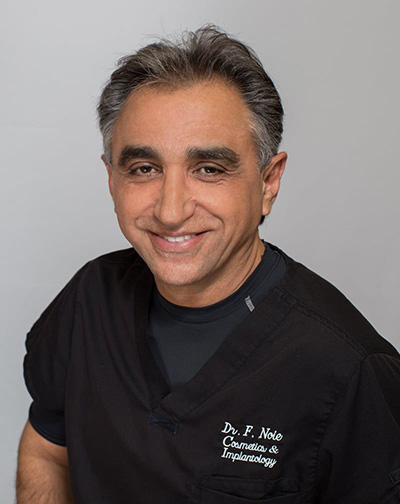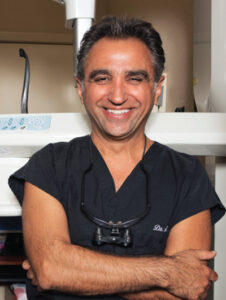 By Farid Noie
By Farid Noie
In less than two decades, dental implants have revolutionized the dental industry by becoming the clear choice, as well as the standard of care for replacing lost or missing teeth. No other treatment option in history of modern dentistry has ever gained so much momentum in such brief period of time.
Chances are, our children will only learn about dental bridges and removable appliances in their text books (or Wikipedia), alongside other obsolete treatments such as bloodletting and electroconvulsive shock therapy.
Perhaps that’s mainly why so many patients and practitioners still are on the fence about dental implant treatment. This reluctance on the part of both clinicians and patients to recommend and choose dental implants in my opinion is largely due to several myths surrounding dental implants. The purpose of this article is to examine these myths from a factual and scientific point of view. Here are some of the more common concerns that my patients and colleagues have expressed to me.
1. MYTH: Dental implants cost more than other traditional options.
FACT: The cost of dental implants can vary based on the usual factors such as geographic location, individual office fee policies and overhead, experience and reputation of practitioner, and degree of difficulty. However, the same is true with almost any other service or product such as dental bridge and, partial or full denture. Dental implant treatment consists of three separate parts; implant body, implant abutment and the crown. The body is the titanium cylinder that is placed inside the jawbone. The abutment is the part of the dental implant that is placed on top of the dental implant body once it has successfully integrated with the jawbone. The Implant crown is very similar to the natural tooth crown you receive at your dentist office. It is usually made out of porcelain or porcelain fused to metal in the shape of the intended tooth and is fixated to the abutment the same way a porcelain crown to a natural tooth.
In my office a single dental implant procedure with includes all three parts, actually costs less than a fixed dental bridge. In my opinion what has given rise to this myth is mainly the fact that insurance companies have been slow to include dental implants as a viable treatment option. In other words, dental Implants popularity has risen faster than federal and state legislation process. While some insurance companies have elected to voluntarily extend coverage for them, most are waiting for state legislators to officially mandate them to do so. This coverage limbo, however, should not play a vital role in our choice of treatment options. The main emphasis should be what is best for the patient, both in short and long term. Insurance companies have determined that the average lifespan of a fixed dental bridge is between 5-10 years.
For that reason, almost all insurance companies will often pay to replace a bridge as frequently as every five to six years. That means, every time the bridge needs to be replaced, the patient has to pay at least half or more of the cost each time each time it occurs. And every time a dental bridge is replaced, the likelihood that the teeth serving as abutments will fail increases. In my office, a properly cared for dental implant can last a life time. Therefore, while the short term cost of a fixed bridge will be split between patient and his insurance provider, in the long run the fixed bridge will certainly cost more out of pocket than a dental implant.
While dental professionals do not agree on everything, there is one thing that all dental professionals, as well as American Dental Association unanimously agree upon. Effective daily brushing and flossing is clearly the most important factor in preserving natural teeth. A fixed bridge greatly hinders a patient’s ability to effectively remove plaque and tartar build up from under the bridge without damaging the delicate gum which almost certainly leads to recurrent decay and gum disease between the bridged teeth.
That is why fixed bridged post teeth are five times more likely to be compromised than non-bridged teeth. The other option is removable teeth, also known as partial denture. Unfortunately they have even more serious flaws than fixed dental bridges. Most patients are not satisfied with this alternative due to the bulk of metal and acrylic and the unsightly clasps necessary to stabilize the prosthesis. About half the patients who choose this option can’t eat with them — which is why they end up spending more time in their pocket, purse, or drawer than their mouth. Another major consequence of this option is the bone loss that occurs due to the absence of bone stimulation that is normally exerted on jawbone by natural tooth root. Many patients complaint that biting forces will cause the partial to move and shift because its design lacks a secure connection. Next month we will discuss other myths surrounding replacing lost teeth and dental implants.
2. MYTH: Tooth #3 is missing and #2 and #4 are heavily restored and require crowns anyway. It is probably best to provide this patient a 2 x 4 bridge instead of an implant at #3.
FACT: While this appears reasonable when taken at face value, it is not logical. If teeth #2 and 4 were virgin teeth, no one would argue that an implant should certainly be placed at #3 to avoid having to unnecessarily prepare these unrestored teeth. However, when one thinks logically, why would a clinician take two heavily restored teeth, crown them, and then hang a third tooth onto them, thus increasing their load? The logical thing to do would be to crown each of these teeth individually and then perform a dental implant at #3 and let each of the three teeth stand alone supporting only themselves. Thus, one does not unnecessarily increase the load on already compromised teeth.
3. MYTH: Implants are somewhat experimental.
FACT: Implants not only are no longer experimental with 40 years of data behind them, they now are the standard of care. Straumann provides international statistics of 96 percent success rate for dental implants and other implant companies provide similar success rates. These are better statistics than one can often provide for natural teeth! When faced with a tooth that might require crown lengthening and extensive restorative work with a questionable prognosis, a much more predictable alternative is often removal of that tooth and placement of a dental implant.
4. MYTH: Implants in the anterior region are not as aesthetic as bridgework.
FACT: Implants actually provide greater aesthetics than bridgework when properly placed. The key is proper site preparation prior to the implant placement.
5. MYTH: Implant placement and associated bone or soft tissue grafting are very painful.
FACT: Dental implant placement is one of the most comfortable procedures performed by the oral and maxillofacial surgeon, allowing most patients to resume normal activities the following day!
These are just some of the myths surrounding dental implants. Our challenge as clinicians is to educate our patients regarding the predictability and desirability of anatomic replacement of missing teeth by adding dental implants rather than settling for subtractive dentistry with bridgework and partials. Many patients have already accepted the life-changing benefits of dental implant treatment. As these numbers continue to increase, the positive “buzz” surrounding dental implants will also increase and patients will become more active consumers of these services.
 Dr. Noie has been in private practice in the Bay Area since 1996. He is a Diplomate of Int’l Congress of Oral Implantologists, Fellow of Academy of General Dentistry, and Assoc. Fellow of American Academy of Implant Dentistry. He has completed his surgical training at New York University as well as Medical University of South Carolina, Temple University, and Wright state University School of Medicine. He completed his oral Anesthesiology training at University of Alabama in Birmingham. He is a member of American Academy of Cosmetic Dentistry.
Dr. Noie has been in private practice in the Bay Area since 1996. He is a Diplomate of Int’l Congress of Oral Implantologists, Fellow of Academy of General Dentistry, and Assoc. Fellow of American Academy of Implant Dentistry. He has completed his surgical training at New York University as well as Medical University of South Carolina, Temple University, and Wright state University School of Medicine. He completed his oral Anesthesiology training at University of Alabama in Birmingham. He is a member of American Academy of Cosmetic Dentistry.




 By Farid Noie
By Farid Noie Dr. Noie has been in private practice in the Bay Area since 1996. He is a Diplomate of Int’l Congress of Oral Implantologists, Fellow of Academy of General Dentistry, and Assoc. Fellow of American Academy of Implant Dentistry. He has completed his surgical training at New York University as well as Medical University of South Carolina, Temple University, and Wright state University School of Medicine. He completed his oral Anesthesiology training at University of Alabama in Birmingham. He is a member of American Academy of Cosmetic Dentistry.
Dr. Noie has been in private practice in the Bay Area since 1996. He is a Diplomate of Int’l Congress of Oral Implantologists, Fellow of Academy of General Dentistry, and Assoc. Fellow of American Academy of Implant Dentistry. He has completed his surgical training at New York University as well as Medical University of South Carolina, Temple University, and Wright state University School of Medicine. He completed his oral Anesthesiology training at University of Alabama in Birmingham. He is a member of American Academy of Cosmetic Dentistry. Finally, “Teeth in a day” is a predictable and affordable reality. It is estimated that more than 35 million Americans, due to various reasons, have lost their teeth and are reluctant to wear a removable appliance in order to be able to eat.
Finally, “Teeth in a day” is a predictable and affordable reality. It is estimated that more than 35 million Americans, due to various reasons, have lost their teeth and are reluctant to wear a removable appliance in order to be able to eat.

